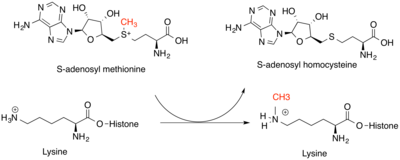User:Etabs1089/sandbox
Introduction

Methyltransferases are a large group of enzymes that all
Function
Genetics
Regulation
Methylation of proteins has a regulatory role in protein-protein interactions, protein-DNA interactions, and protein activation.
Examples: RCC1, an important mitotic protein, is methylated so that it can interact with centromeres of chromosomes. This is an example of regulation of protein-protein interaction, as methylation regulates the attachment of RCC1 to histone proteins H2A and H2B. The RCC1-chromatin interaction is also an example of a protein-DNA interaction, as another domain of RCC1 interacts directly with DNA when this protein is methylated. When RCC1 is not methylated, dividing cells have multiple spindle poles and usually cannot survive.
p53 methylated on lysine to regulate its activation and interaction with other proteins in the DNA damage response. This is an example of regulation of protein-protein interactions and protein activation. p53 is a known tumor suppressor that activates DNA repair pathways, initiates apoptosis, and pauses the cell cycle. Overall, it responds to mutations in DNA, signaling to the cell to fix them or to initiate cell death so that these mutations cannot contribute to cancer.
Natural product methyltransferases provide a variety of inputs into metabolic pathways, including the availability of cofactors, signalling molecules, and metabolites. This regulates various cellular pathways by controlling protein activity.
Types
Histone Methyltransferases

N-terminal Methyltransferases

N-alpha methyltransferases transfer a methyl group from SAM to the
DNA Methyltransferases
Natural Product Methyltransferases

Natural product methyltransferases (NPMTs) are a bdiverse group of enzymes that add methyl groups to naturally-produced small molecules. Like many methyltransferases, SAM is utilized as a methyl donor and SAH is produced. Methyl groups are added to S, N, O, or C atoms, and are classified by which of these atoms are modified, with O-methyltransferases representing the largest class. The methylated products of these reactions serve a variety of functions, including co-factors, pigments, signalling compounds, and metabolites. NPMTs can serve a regulatory role by modifying the reactivity and availability of these compounds. These enzymes are not highly conserved across different species, as they serve a more specific function in providing small molecules for specialized pathways in species or smaller groups of species. Reflective of this diversity is the variety of catalytic strategies, including general acid-base catalysis, metal-based catalysis, and proximity and desolvation effects not requiring catalytic amino acids. NPMTs are the most functionally diverse class of methyltransferases. [6]
Important examples of this enzyme class in humans include
Non-SAM Dependent Methyltransferases
Clinical Significance
Further Reading
"The Role of Methylation in Gene Expression" on Nature Scitable
"Nutrition and Depression: Nutrition, Methylation, and Depression" on Psychology Today
"DNA Methylation - What is DNA Methylation?" from News-Medical.net
References
- S2CID 16966511.)
{{cite journal}}: CS1 maint: unflagged free DOI (link - PMID 21131967.
- ISBN 0865427437.
- PMID 22473383.
- S2CID 711645.
- PMID 22850796.
- ^ "PNMT phenylethanolamine N-methyltransferase". NCBI Genetic Testing Registry. Retrieved 18 February 2014.
- ^ "HNMT histamine N-methyltransferase". NCBI Genetic Testing Registry. Retrieved 18 February 2014.
- ^ "COMT catechol-O-methyltransferase". NCBI Genetic Testing Registry. Retrieved 18 February 2014.

